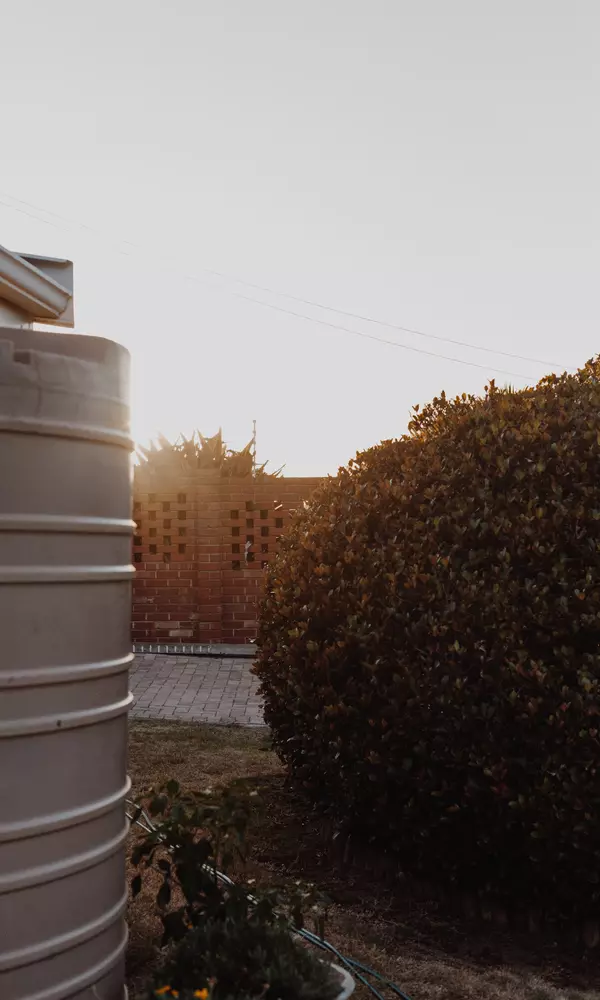
The disadvantages of rainwater harvesting are real but also easy to overcome. We’ve all seen the news stories imploring us to use less water.
You can shut off the tap while brushing your teeth. Use reduced-flow faucets to wash our hands, and installing low-flow toilets in our bathrooms.
But what about using rainfall to reduce our dependence on the local water grid?
Unfortunately, some difficulties exist when it comes to rainwater harvesting. This is one reason we don’t use rainwater collection barrels as often as we do other eco-conscious items.
It is comparatively easy to buy sustainable products such as shoes made from recycled plastic, plastic-free shampoo bars, and sustainable dental products. Installing a rainwater harvesting system takes more than a few clicks of your mouse.
However, overcoming these disadvantages isn’t impossible. Many municipalities worldwide already use rainwater collection systems to boost the local water supply.
Is it possible or convenient to bring these water harvesting techniques to the modern home? Let’s find out by comparing some disadvantages of rainwater harvesting and some potential solutions.
Why Is Rainwater Harvesting Important?
First, before we get all Debbie Downer with some of the challenges, let us build up your motivation. There are many reasons why rainwater harvesting is important for the environment.
Of course, harvesting water from your roof is good for your wallet since it reduces your water bill. But you will also help the environment. Some of the key ways rainwater harvesting helps the environment include:
- Keep pollution out of rivers: Capturing rainwater before it hits the sewers reduces run-off. Rain water run-off washes all types of nasty byproducts into waterways, including pesticides, motor oil, and excess fertilizer and soil.
- Keep poo out of waterways: Intense downpours can overwhelm sewer systems, forcing water companies to release untreated sewage (that is, human excrement) straight into rivers and other bodies of water.
- Fight droughts: Reducing demand on water infrastructure gives groundwater sources and reservoirs a chance to replenish, especially important if you live in an area of the world subject to drought (something that will likely increase in the decades to come because of climate change)
Nothing good in life is free though. When you sign up to start harvesting rainwater, you need to consider some of the disadvantages. Let’s start with going off the grid with rainwater harvesting.
Complete Water Independence is Difficult
Consumers have a range of rainwater harvesting options to choose from. You can go with a full-scale survivalist setup that creates total water independence. But you also have less-extensive set-ups meant to augment the water supply at a family’s suburban or city home.
One of the most significant difficulties rainwater harvesters face is using the system for drinking water rather than solely for outdoor needs like watering the lawn or washing the cars.
Creating drinking water from rainwater harvesting means installing a system of filtration devices, which can skyrocket costs. Also, if you choose to create a potable rainwater harvesting system, it could be subject to regulation by local authorities.
Potable systems can have stringent regulations, including regulating the materials used on your roof, gutters, piping, etc. You’ll need to pay attention to manufacturers’ third party certified ratings to ensure they are rated for potable water.
Also, if your house has some types of roofing material, you need to think twice about harvesting rainwater for potable water. Asphalt shingles are not ideal for potable water, nor are wood or cedar. Asphalt shingles can be treated with herbicides to combat moss growth too.
If you have a cedar roof, you may think twice about using it for gardens. The water can have high levels of toxicity.
However, you don’t need to achieve complete water independence to find value in a rainwater harvesting system. The average lawn in the United States is 10,871 square feet. It takes 6,740 gallons to water that yard with the oft-recommended one inch of water.
Every gallon you collect is a gallon less that you need to use from the tap to water your lawn or flush your toilets.
The planet and your budget will thank you for your effort. All it takes is a quick calculation of how many barrels you’ll need. The general rule is that one inch of rainfall on a 500 sq. ft. of roof space will give you around 300 gallons.
Installation for Rainwater Harvesting is Complex
Even if you’re not pursuing complete water independence with your rainwater harvesting system, you might find the complexity of its installation somewhat intimidating. Even if you’re not building filters and tank systems capable of storing potable water.
In our review of the two best rain barrels made from recycled plastic, we discuss the installation process.
Some of the tasks you’ll need to complete for a modest rainwater harvesting system include:
- figuring out how many barrels to install,
- adjusting the downspouts on your house to accommodate the barrels, and
- ensuring that mosquito nets cover the open surfaces of the barrels. The net will also keep other bugs and leaves out of the water.
You may need tools like metal cutters or a hacksaw for the downspouts. If you decide to use a plastic drum found on Amazon and make it into a rain barrel, you will need power tools to create holes in the rain barrels for spigots and overflow valves.
If you’re not a DIY-oriented person and have never used a power tool, a rainwater harvesting system is still within your reach.
Installation of a simple system, or even one barrel designed to harvest rainwater, by a local contractor or handy person isn’t going to cost you an arm and a leg. Especially if you are just installing a simple system with a few barrels for watering your lawn or other non-potable uses.
Or if you are reasonably handy, installing a few rain barrels is probably something you can tackle. We believe in you!
Some Rainwater Harvesting Systems are Prohibitively Expensive

If you live in a place where it rains frequently, you might want to save every ounce of water that falls on your house. Unfortunately, one of the biggest disadvantages of rainwater harvesting systems is their cost.
Large water storage tanks get pretty expensive. It’s not uncommon for a 5,000-gallon water storage tank to cost $4,000 to $5,000.
However, you don’t necessarily need to purchase an enormous storage tank to hold the water that collects in your harvesting barrels. A storage tank is useful when building a system for potable water consumption.
But you can start with a much smaller-scale system where you use water directly from your harvesting barrels for various uses around the home.
You can fill up a watering can from the spigot on your barrels and water your plants. Or sprinkle some in your compost pile to keep it moist and speed up composting cycles.
Water your indoor plants with rain water. Or, to achieve true eco-warrior status, you might also fill a standard bucket and then use the water to fill the toilet tanks around your house.
Rainwater Harvesting Takes Up a Lot of Space
Some urban areas have the tiniest yards imaginable and houses that take up almost every inch of the yard. You might think it impossible to build a rainwater harvesting system if you don’t have a giant yard. However, you can always start small with just a few basic barrels and still enjoy the benefits of water collection.
An extensive off-grid setup will probably require a lot of room. Room that you likely don’t have if you live in a dense, urban area like Los Angeles, Boston, or Manhattan. Keep in mind though, you don’t have to buy the biggest barrels available to benefit from rainwater harvesting.
In fact, some rainwater barrels hold just 26 gallons of water and feature a relatively narrow footprint. You can install them even if you only have a few feet of room between your home and the house next to yours.
Getting the Greatest Benefit of Rainwater Harvesting Takes Time
You can maximize your rainwater harvesting system when you’re willing to empty your barrels regularly. Pay close attention to the amount of precipitation your home receives each day. Still, not everyone has the time or inclination to put yet another household duty on the list.
Maximizing your rainwater collection system means some extra steps to automate the collection process.
But don’t fret. Installing an automated system can be as simple as attaching soaker hoses, which are cheap and easy to install. You can even find soaker hoses made from 100% recycled material.
This allows you to keep the spigots open all the time. Water seeps out as gravity pushes it down. Oh, that reminds us of another disadvantage, you will need some help from Issac Newton to empty your barrels.
Most Rain Barrels Rely on Gravity
Unless you install a pump to push or suck the water out of your barrels, you are going to have to find a way to take advantage of gravity.
Elevate your rain barrel to take advantage of gravity’s power. Otherwise, you will find emptying your rain barrels is time-consuming.
For first-time rain harvesters, it can be jarring to see how slow the water flows from your barrel. Especially as compared to the jet of water coming out of a hose attached to your spigot. But the higher you place the barrels, the easier and quicker it is for you to empty them.
Try placing your barrels on cinderblocks, thick wood beams, bricks, or this attractive wood rain barrel stand available on Amazon.
Rainwater Harvesting Barrels Aren’t Made for Looks

Big plastic barrels lined up along the side of your house aren’t a beautiful sight. But a rainwater collection system isn’t meant to enhance your home’s visual appeal.
And, if you’re genuinely annoyed at the presence of a few 50-gallon rain barrels sitting on the side of your house, it’s always possible to paint them or build an enclosure to hide them.
Or consider this: display your big, ugly rain barrels with pride as you encourage others around you to adopt the same attitude toward the environment. The planet is worth saving, and every little bit of water we save helps turn back the clock on climate change.
You can find some more attractive rain barrels on the market. Typically under 100 gallons and some planters embedded in the top.
Or, get yourself a rain barrel shaped to look like old-timey barrels, like the RTS rain barrel or FCMP’s Rain Catcher barrel, both made of recycled plastic.
Benefits of Rainwater Collection Systems, Large and Small
Rainwater harvesting is a concept that’s both ancient and new. Our ancestors used rainwater collection for survival, while most city dwellers today use it to save money and save the environment. The disadvantages of rainwater harvesting aren’t impossible to overcome.
We don’t have to use rainwater collection systems, but we can. It’s easy to start with just a few barrels and an afternoon spent installing a few pieces of equipment.
Whether you invest in a comprehensive rainwater collection system or just a few barrels, you’ll enjoy some excellent personal satisfaction in collecting rainwater and using it around your home.
Further Reading
Essential Rainwater Harvesting: A Guide to Home-Scale System Design: To go full-on water independence, this engineering-oriented book has a wealth of info.
Here at R&R we only endorse products we have owned, tested, and fell in love with. If you end up making a purchase through one of our affiliate links, we may earn a very small commission that offsets the cost of hosting, building, and maintaining this site. We encourage purchasing products directly from companies since many of the ones we highlight are small businesses. When possible, we provide the link to the company website and Amazon to provide both options for you.